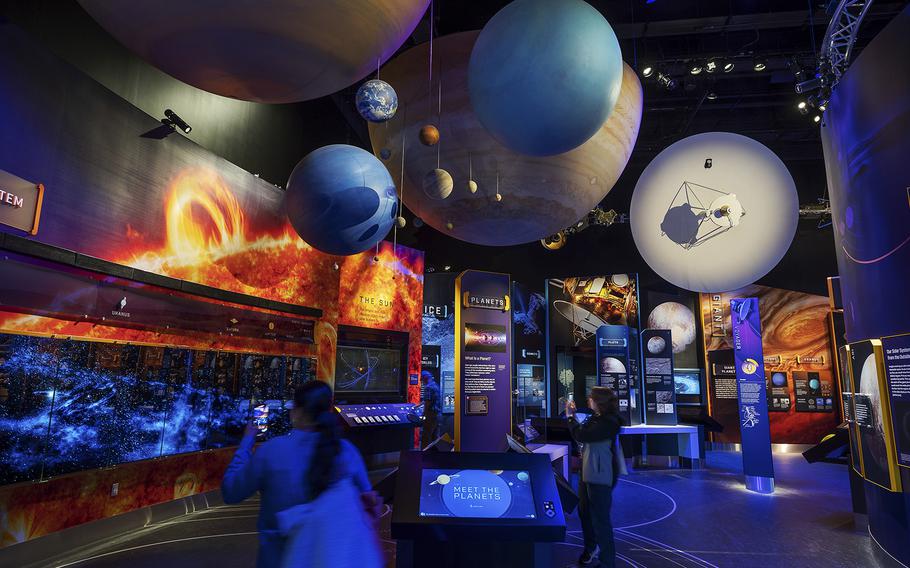
The Kenneth C. Griffin Exploring the Planets Gallery is one of eight galleries available to visitors as the National Air and Space Museum reopens on the National Mall. (Craig Hudson for The Washington Post)
WASHINGTON - Before the pandemic, the National Air and Space Museum was one of the most popular museums in the world. It drew 6.2 million visitors in 2018 - behind only the Metropolitan Museum of Art in North America - and remained the fifth most popular on the continent in 2019, despite closing some exhibits for the beginning of an extensive multiyear renovation and rehabilitation.
"Millions of visitors can take a toll on a museum space," says Jeremy Kinney, the museum's associate director for research and curatorial affairs.
This weekend, visitors will finally see the results of that transformation in eight revamped galleries, including two with themes new to the museum. Some of the jewels of the collection, including the Wright Flyer, Neil Armstrong's spacesuit and the Apollo 11 Command Module Columbia, are in new, inspiring settings. Swept away were the carpeted hallways and the dusty and boring galleries. And of the 1,240 artifacts on display, the Smithsonian boasts that 55 percent of them have never been on display in this museum before, from the supersonic Northrop T-38 Talon in which trailblazing pilot Jacqueline "Jackie" Cochran set eight world records to an X-wing starfighter featured in "Star Wars: The Rise of Skywalker" and prosthetic ear tips worn by Leonard Nimoy as Mr. Spock on "Star Trek."
If you're lucky enough to have a timed ticket - more on those below - or are planning a visit soon, here's what you need to know.
The exhibits center objects in new and different ways.
While a large number of artifacts are new to the Mall, that's not the case with some of the most famous. Take the Wright Military Flyer: Built in 1909 and flown that year at Fort Myer in a demonstration for the U.S. Army, it still has its original fabric covering. Bigger and beefier than the famous 1903 Wright Flyer, it was previously displayed hanging from the ceiling. But now, in the Early Flight gallery, it's down at eye level, just like the better-known Wright brothers plane, which has its own place of pride in a gallery down the hall.
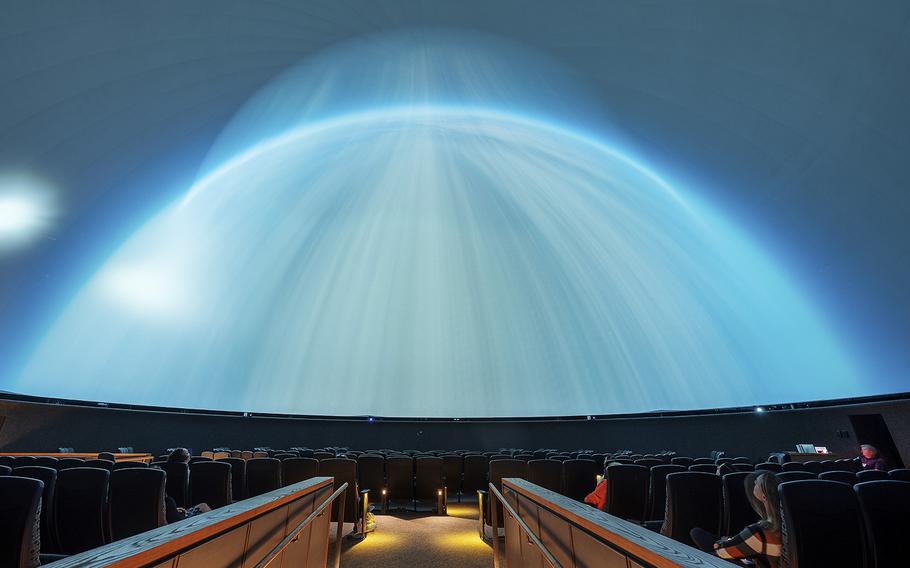
A look inside the planetarium at the Air and Space Museum. (Craig Hudson for The Washington Post)
Columbia, the command module for the Apollo 11 mission, was previously in the Boeing Milestones of Flight Hall, "behind Plexiglas," Kinney says, almost in disbelief. In the Destination Moon gallery, it's in a central location in a custom-built case that allows visitors to walk around it, examining the damage caused by the heat of reentry, and trying to imagine three people living inside for any period of time. (Make sure to see the video screen behind Columbia, which shows features of the cramped quarters, from the lockers to the seats, and even offers a view of Michael Collins's famous post-splashdown inscription on one of the instrument panels.)
"Visitors interact with exhibits in different ways," Kinney says. "Some read all the labels, some want the interactive. We have visitors who have a checklist - they're coming to see the first airplane. Others are genuinely curious. The space is designed for this - you want to have the artifact, but you also have the story behind it," so people can put the object in context. The museum is also approaching different groups of visitors, using models or hands-on components for visitors who might have vision or mobility issues, for example.
For Destination Moon, which has some of the Smithsonian's most prized artifacts, it was a matter of shaping the exhibit for a different, younger audience. "We had an Apollo to the Moon gallery in the old museum, but it needed to be re-contextualized," Kinney says. "When the museum opened [in 1976], moon landings were a recent memory." Now, it has been 50 years since a human walked on the moon, and fewer visitors recall where they were when Neil Armstrong stepped onto the Sea of Tranquility. There's more information about the space race and its role in the culture of the time.
There's also a desire to tell a wider group of stories: Near the main entrance is the WR-3, a racing plane built by Neal Loving, the first Black pilot and double amputee certified to race airplanes. A display in the Thomas W. Haas We All Fly gallery highlights Jerrie Mock, who took up flying as a hobby and became the first woman to fly solo around the world in 1964. Both planes were previously on display at the Steven F. Udvar-Hazy Center in Chantilly but now have a more prominent position in the nation's front yard. In Destination Moon, one display addresses "Why only White male astronauts?" by telling visitors about the Mercury 13 - a group of women who passed the same physical tests as NASA astronauts but were never accepted into NASA programs.
Get ready to get interactive.
Artifacts are essential to telling the museum's stories, whether it's the spacesuit that Armstrong wore while hopping around the lunar surface or the stopwatch the Wright brothers used to time their test flights at Kitty Hawk. But looking at objects isn't going to touch every visitor, especially the younger ones. Air and Space has always had flight simulators and interactive games and stations, but the revamped galleries go far beyond anything seen before.
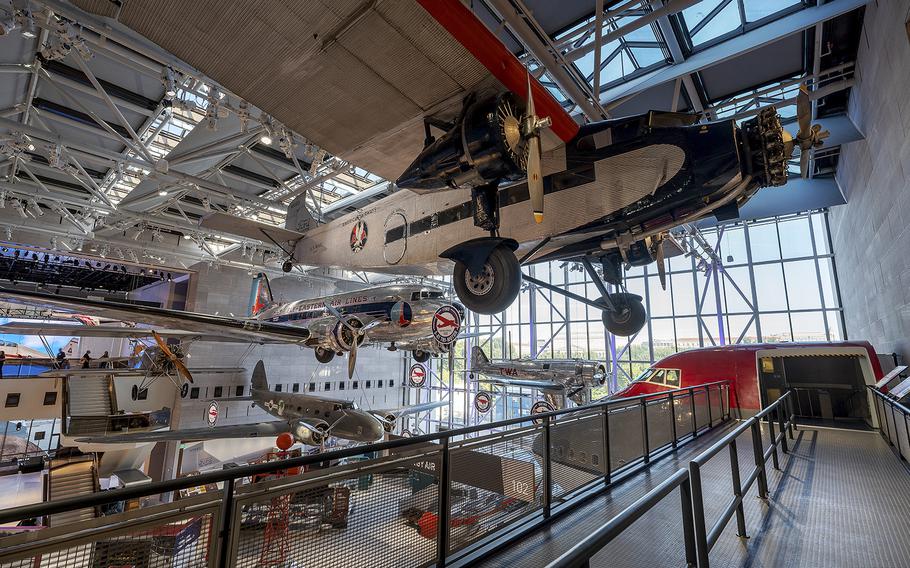
The America By Air hall looks at the history of commercial aviation in the United States. (Craig Hudson for The Washington Post)
The most immersive experience is "Walking on Other Worlds" in the Kenneth C. Griffin Exploring the Planets Gallery. Visitors walk into the middle of a circular space, more than 25 feet in diameter, surrounded by video screens. Over the course of seven minutes, they're taken to seven locations throughout the galaxy, including Jupiter's moon Titan, Mars and the surface of a comet. With almost 360 degrees of visuals, you can swivel around to see details - the remains of the Huygens Probe, which crashed into Titan in 2005, the rocky red outcrops so familiar from the Perseverance Rover's Instagram feed - while facts appear on the screen, pop-up-video style, talking about the temperature, gravity or surface features. (Methane lakes on Titan? Awesome.) Think of it as virtual reality without the helmet.
Over near the models of Mars rovers, a touch-screen game asks visitors to pilot a rover on missions across the Red Planet's surface, weighing risks of getting stuck versus the chance of scientific discovery, and investigating whether sites may show evidence of water before the solar clock runs down. Throughout the museum, there are chances to build your own solar system, choose the most important elements of a flying car, or track flights and animal migrations projected onto a 10-foot globe.
There are more "traditional" elements to touch and play with, too, such as pulling levers in the Wright brothers gallery to demonstrate the concept of wing warping or moving joysticks in America By Air to show how flight controls, such as rudders and wing flaps, have changed over the years. One of the most basic - and most compelling - is the Evel Knievel pinball machine in Nation of Speed. Visitors are challenged to "jump" a pinball across a chasm, similar to one of the daredevil's stunts, but have to play around with the speed of the ball and angle of ramps to successfully land on the other side.
The museum is not just about air or space.
If we're being honest, some of the galleries feel similar to the old displays. America By Air, for instance, tells the story of passenger air travel, with its display containing Emilio Pucci's swinging '60s stewardess fashions and a walk-through Douglas DC-7, which is absolutely dwarfed by the nose of a Boeing 747. But that's not always the case.
Nation of Speed, one of the new exhibit themes, explores America's obsession with things that move really fast while making a lot of noise. This was a collaboration between Air and Space and the National Museum of American History, which lent items including racecars driven by Richard Petty and Mario Andretti. Sure, Kinney concedes, each museum could have crafted its own exhibition about the need for speed, but it made more sense to join forces, even if, he says with a smile, "we have the fastest artifacts."
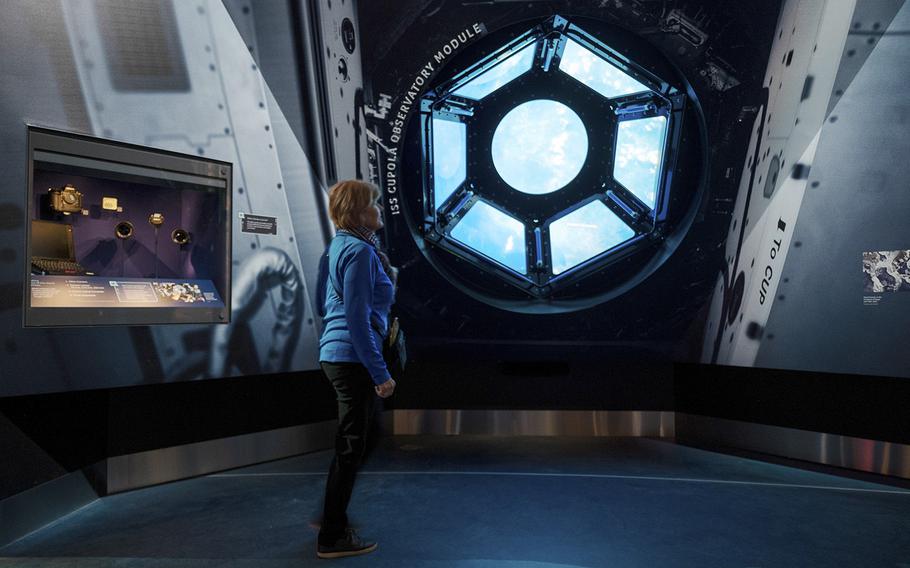
The One World Connected exhibit includes an interactive activity that re-creates the International Space Station’s Cupola and offers a view of Earth from space. (Craig Hudson for The Washington Post)
The gallery prominently centers the story of Air Force Col. John Stapp, whose 632 mph ride in the rocket sled Sonic Wind 1 exposed him to a G-force of 46.2 - the most faced by a human - and made him "the fastest man alive" while researching rapid acceleration and deceleration. Stapp's experiments help set safety standards for both aircraft and cars.
Kinney says the guiding principle here was, "How can we do an exhibit that's out of the box?" And it certainly is, compared with the focused tales in the other galleries. Here, the displays wander between racing aircraft, rocket engines, record-setting motorcycles and a case of toys, from a Barbie-sized Corvette to Matchbox planes to a three-foot-high model of a German V-2 rocket, which shows how our desire for machines that go faster, faster, faster is imbued at a young age.
There are some curious inclusions, from a 1980s crash test dummies commercial and bricks from the Indianapolis Motor Speedway to the taxidermied remains of Gilmore the Flying Lion, the pet of charismatic plane racer Roscoe Turner. (Turner, who broke transcontinental speed records in the 1930s, was sponsored by Gilmore Oil Company, owner of the Red Lion gasoline brand. "It was all about advertising," Kinney says.) The lion had its own parachute when it flew with Turner - which it did for only nine months, the display says, "until Gilmore grew too big" to fit in the cockpit.
"It's a temporary exhibit," Kinney says, but don't rush: In Air and Space terms, that means it's going to be around for a decade.
Not all of the museum's iconic artifacts are on display.
Whether you grew up visiting the Air and Space Museum frequently or you had your life changed by a seventh-grade field trip, you probably had a favorite thing you've seen again and again: the moon rock, Chuck Yeager's sleek Bell X-1 jet, the walk-through Skylab orbital workshop, the puppet theater telling the story of the first balloon flight over the English Channel.
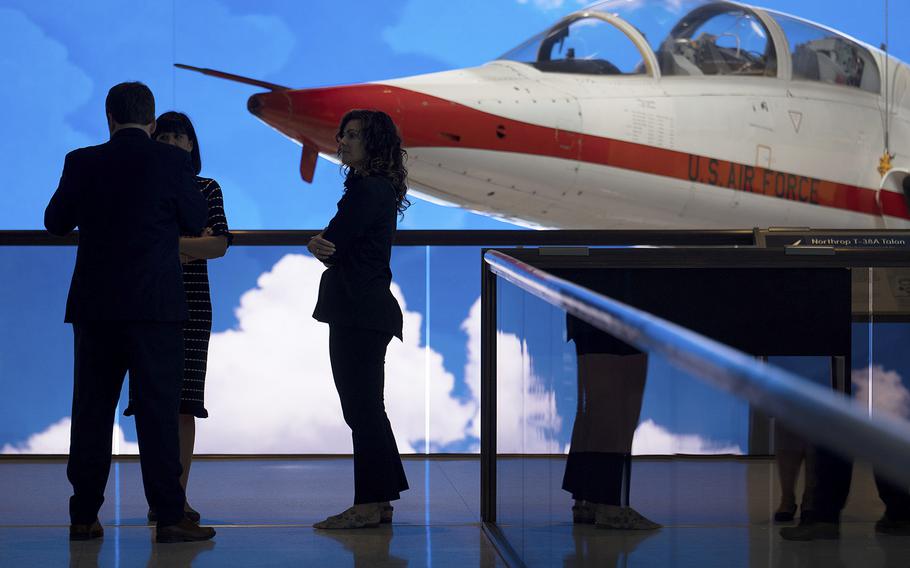
The Northrop T-38 Talon flown by Jacqueline “Jackie” Cochran, the first woman to break the sound barrier. (Craig Hudson for The Washington Post)
But with only eight of the 23 exhibition and display areas reopened, there's just not space to show everything. Some artifacts, like Yeager's sound-barrier-shattering Glamorous Glennis, have been relocated to Udvar-Hazy during renovations, along with John Glenn's Friendship 7 capsule and Gemini IV. Many artifacts remain in storage, including the moon rock and Skylab.
Some decisions are more complicated. Charles Lindbergh's famous Spirit of St. Louis, used on the first transatlantic flight, is awaiting installation in a new gallery, but in the meantime, museum director Chris Browne didn't want to keep the aircraft off public view, according to spokesperson Alison Mitchell. So if you go up to the second floor and walk past the One World Connected exhibit, you can peer around a corner and, behind velvet ropes, see the shining silver plane.
Getting in might be tougher than you think.
There's a lot of interest in the renovated museum, and the Smithsonian has turned to free timed entry passes to handle the expected crowds. About 8,000 will be available per day at first, though that could change. This weekend, Friday through Sunday are already full, as is Oct. 22. A limited number of same-day passes will become available online each day at 8:30 a.m.
The museum will be open daily from 10 a.m. to 5:30 p.m., except for Christmas, and passes are required for everyone. Tickets for a new group of dates are released every six weeks; on Sept. 14, the museum opened all dates between Oct. 14 and Nov. 30 for reservations. On Oct. 28, visitors will be able to reserve dates between Dec. 1 and Jan. 14, and then on Dec. 16, reservations become available for dates between Jan. 15 and Feb. 28.
Passes allow admission at the top of the hour between 10 a.m. and 4 p.m. (for example, you can't reserve passes for 10:30 a.m.). Visitors should arrive no more than 15 minutes before their admission time, and at busy periods, the museum advises that it may take up to 30 minutes to actually enter. Passes allow entry for up to an hour after the time on the ticket; after that, admission depends on the museum's capacity.